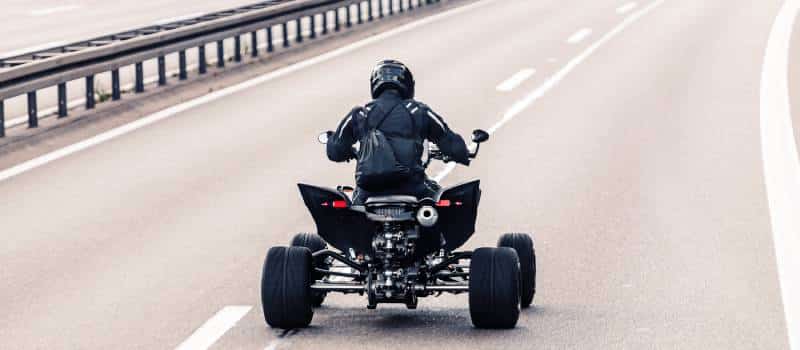ATVs are recreational or utility vehicles. They are also vehicles used in sporting activities and off-road competitions in some states or countries. Unfortunately, in the United States, ATVs are not allowed to be used as personal transportation on public streets or highways. Authorities base this prohibition on the fact that the standard configuration of the ATV does not represent sufficient safety for the driver and the rest of the people who usually travel on streets and highways. So, is it not possible to make the ATV legal and use it on the streets?
Yes, it is possible to make your ATV legal to circulate on streets and highways, as long as it complies with all the legal requirements demanded by the place where you will use it. Additionally, you should make the necessary investment in accessories and components to make your ATV a safe vehicle.
In this crusade to make our ATV legal, we must mention the challenge that represents not having a single list of requirements that you must comply with during this legal process. Each country, region, state, and even specific industry may have its list of regulations and requirements for being on the road. For example, in the United States, each state is different. Some certain counties or municipalities also have their laws. For these reasons, before you start spending money on your ATV, we recommend that you continue exploring this article to learn more about this topic.
Are 4-wheeler-like ATVs Legal On The Road? What Are The Reasons Why ATVs Are Not Street Legal?
We already know that people use ATVs widely on farms, ranches, and sports competitions. Some states in the U.S. allow ATVs to travel on snow or snowmobile trails when cars can't cross the road.
However, fans of these vehicles do not fully understand why they cannot legally ride on the streets. Mainly because most ATVs are cost-effective when it comes to fuel consumption. But to clear up some of these doubts, here are some reasons why ATVs are not legal for streets and highways.

They Have Different Types Of Tires
At first glance, an ATV might look much safer than a motorcycle because of its enormous tires. The main point is that ATVs have broader and larger treads. This fact means that they are tires designed specifically for rough dirt roads, so they would not be suitable for paved or flat roads. This type of tire on paved roads does not guarantee stability and balance. Therefore, there is a high probability that the vehicle will roll over.
ATVs Are A Heavyweight
An ATV weighs twice as much as a motocross bike. This fact means that a riding error involving a fall can mean a severe injury to its rider. It is also considerable risk for pedestrians in the vicinity.
ATVs Lack Road Safety Features
Conventional four-wheeled vehicles such as buses and cars have safety features such as seat belts and airbags. These elements guarantee the safety of the driver and passengers.
Let's analyze the case of motorcycles and bicycles. We will see that the rider and passengers use helmets as a safety accessory. It is true that with ATVs, you must also use conventional equipment. However, the authorities do not see this as sufficient. ATVs do not have flashing lights, headlights, or crash protection systems.
What Would You Have To Do To Operate Your Four-wheeler ATV On The Road?

Motor vehicles have driving laws that vary from state to state. ATVs are no exception. It is striking that some states do not have fixed rules, and sometimes it depends on the laws where you live. What you may find is the following:
- States that prohibit the use of ATVs.
- States that do not allow legal ATVs even if they don't explicitly say so.
- States that allow street legal ATVs with modifications at the component and accessory level.
Because of all these scenarios, it is best not to invest money before researching in detail what legal requirements each state, city, or county has in place.
Once we have done our homework and concluded that it is feasible to legalize the ATV without problems, we enter the next phase. The next step is to invest in all the modifications required by the entity in charge. As we have already explained, these modifications vary depending on the state. However, below we will review what would be the main accessories that you should generally change.
Headlights
Virtually every state is going to require the ATV to have headlights. However, each state may have different requirements. If your ATV already has one, you should still find out if it meets the technical characteristics required by law.
Taillights
Taillights are also mandatory. These lights are the only signal that cars behind you have to know that you are there. If the ATV has a pre-installed taillight, it may often be of insufficient intensity, so be sure to understand what is required by law.
Turn signals
Not all states require ATVs to have turn signals. But in a few, it is mandatory. In case you already have them, you should make sure they are working correctly.
The Horn
The horn is not a component that determines the legality of the ATV. However, practical riding can be very useful in avoiding accidents on the street or highway.
The Rearview Mirrors
An element that provides excellent safety in handling an ATV on the road is the rearview mirrors. As with other accessories, some states may require them, while others may not. Studying local regulations will always be the key to making changes the right way.
The Muffler
ATVs are typically quite noisy vehicles, and this can annoy pedestrians and neighbors. Installing a muffler on your ATV will make it quieter and, at the same time, community-friendly.
The Windshield
The windshield will be of great use because it will keep insects and windblown debris away from the vehicle. Keep in mind that optimal visibility is also an important safety feature to consider.
The Speedometer
Fortunately, few states require a speedometer on the ATV. We say fortunately because the installation of the speedometer is quite complicated. Many people who have studied the laws beforehand choose to buy an ATV that already has it installed.
Other Requirements To Take Into Account For ATV Street Legality

We have seen some of the accessories and components you usually need to change according to the law. But there are other things you have to manage. There are additional requirements necessary for the total legality of your ATV.
Mount The License Plate And Light
When you have your ATV re-registered to ride on the streets, you must visibly and adequately display the license plate. Many states require that you mount the license plate on the rear of the ATV. In addition to this element, the license plate must be illuminated for nighttime driving and be visible.
ATV Insurance
Insurance is a prerequisite for riding your ATV on the road and city streets.
ATV Title And Registration
You should not be surprised if the police stop you more often when driving an ATV than driving a classic car. For this reason, you should always have your ATV title and registration on hand to avoid uncomfortable moments.
ATV Driving License
For some states, it may not be a requirement to have an ATV driver's license. However, you may be asked for it by a law enforcement officer when they stop you. In that case, the best is to have it on hand at all times.
Inspecting The ATV
This step is necessary to legalize the ATV. It consists of inspecting the vehicle at the licensing department.
A Final Thought On Riding An ATV Legally On The Roads
You have the final decision about making your ATV legal or not. Having the legality of your ATV to drive on the road or street is a great advantage.
But a key aspect to consider is the state where you live. The laws are different per state, but if you confirm that in your state, it will not be allowed to legalize the ATV, it is not worth investing time and money.
But if, on the other hand, street riding is a real possibility, the legal way is an excellent way to expand the use of our valuable and fun ATV.
Shawn Manaher loves to play with new toys and dive into new hobbies. As a serial entrepreneur, work definitely comes first but there is always room for hobbies.

